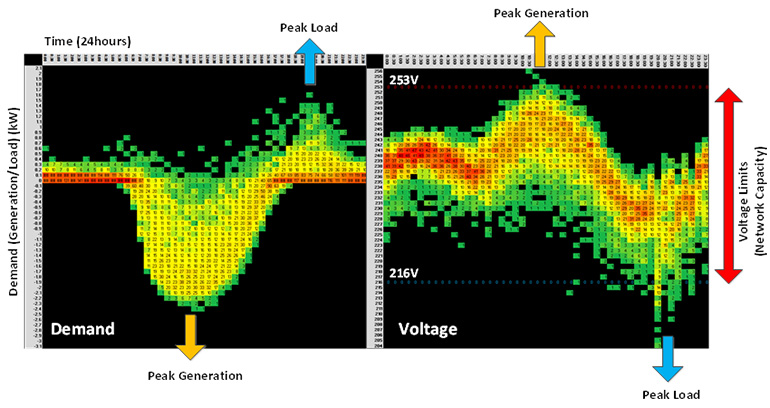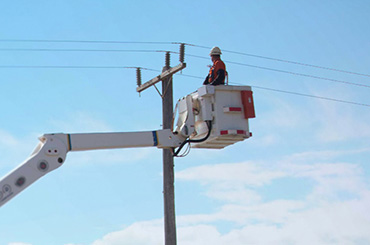Future energy news

20 September 2021
Australia has always been a sun-loving country, and with the largest uptake of household and businesses solar panels installation in the world, we’re continuing that reputation. With nearly 25% of all premises in our footprint now having the capacity to export solar power into the network – our customers are building small power plants on their roofs.For context, the total installed capacity on our network is 868 gigawatt hours, equating to 7% of the total network load and maximum output is 1,172 MW, almost half (47.5%) of our maximum network demand of 2,463MW.
While solar energy production and export provide desirable benefits for both society and directly to customers, early network designers created the grid to manage a one-way electricity flow. This flow ran from large generation plants, through high-voltage transmission lines, stepped down via substations to low-voltage distribution powerlines, and into homes and businesses.
Energy demand was relatively predictable for decades and allowed generators and distribution networks to establish baseloads and build networks to ensure steady, reliable energy. However, solar exports mean the demand curve has now changed. During the day when solar exports are high, the demand for energy is low. But as the sun lowers and solar exports end, people return home and demand a lot of energy. This modern demand curve, shown below, is known as a ‘duck’ curve.

Typical demand and voltage profile from a low voltage premise with solar PV on Essential Energy's network
Solar generation also creates voltage issues for our network and challenges our ability to meet our requirements to maintain voltage within the required limits (upper and lower voltage supply). Typically, our network suffers from low voltage issues when energy demand is high in the evening (image at right). However, solar generation is now giving rise to very high voltages during the day. The difference between this high and low voltage is known as ‘widening of the voltage envelope,’ and it is becoming increasingly difficult to manage.
In the absence of investment that comes at a cost to all customers, the main alternative is to constrain solar exports or even stop solar connections to the network.
However, there is another potential solution – using prices to encourage customers to alter when they consume some of their energy.
Essential Energy is working with customers, retailers, university researchers, and other stakeholders to explore how we can help change customer behaviour and flatten the (duck) curve now.
The Australian Energy Market Commission has recently approved a rule change to allow distribution networks to charge customers for their exports into the grid.
Export charges may help encourage customers to use their solar installations more efficiently. Price signals can discourage exports when they are causing issues on the network and encourage self-consumption or battery charging. Price signals can also encourage customers to shift their energy use away from the evening peak and into the middle of the day. On the reverse side, price signals can also promote customer exports when they can help support the network and allow customers to be paid by networks for this service.
Our existing tariffs mean that customers who do not have access to these solar and battery technologies currently pay a higher share of the network costs to accommodate these services. Introducing an export charge will allow us to lower our other network tariffs and mean that the customers who benefit from solar power and exports can help to fund a greater relative share of the associated costs – which will improve fairness in the prices paid by all of our customers. Most importantly, export charges will allow more customers to connect their distributed energy resources – like rooftop solar systems - to our network.
Essential Energy undertook extensive consultation with stakeholders and residential and small business customers over six months between October 2020 and March 2021 to design the tariffs to take to trial later this year. The trials will determine how customers respond to alternative price signals, the associated bill impacts for customers and whether the tariffs have the potential to be implemented on a broad scale in a cost-effective manner. Some of the concepts being trialled are:
- an export charge, for customers with solar panels
- offering reduced rates for energy consumption between the hours of 10am and 3pm
- encouraging reduced energy consumption during peak demand events between 5pm and 8pm (for no more than 3 hours on up to 15 days a year).
Another trial to eventuate from the consultation was an education only trial, to determine whether behavioural change alone can deliver a sufficient change in consumption without the need to complicate tariffs. The education trial will build awareness around:
- increasing energy consumption between the hours of 10am and 3pm
- limiting energy consumption between 5pm and 8pm
- improving energy consumption through appliance choice and use
- how customers can change their behaviour to lower their electricity bill.
In addition, the trials will measure the tariffs abilities to help solve voltage and capacity (thermal) constraints on our network and improve overall utilisation. The learnings from these trials will directly inform our customer engagement and proposed tariffs for our next regulatory period that begins on 1 July 2024 and runs through to 30 June 2029.



